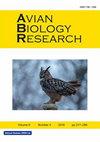RNA保存方法对现场采集的禽类全血RNA数量和质量的影响
IF 1.2
4区 农林科学
Q4 AGRICULTURE, DAIRY & ANIMAL SCIENCE
引用次数: 1
摘要
转录组包括样本、组织或生物体中的所有RNA分子。比较转录组学研究通常在不同暴露或处理下比较野生鸟类种群个体之间的基因表达,其局限性仍然是高质量RNA(即将遗传密码从DNA转移、翻译和调节为蛋白质的核糖核酸)的样本保存。野生鸟类血液的现场采样带来了挑战,因为RNA降解过程很快,这在很大程度上是由于鸟类血液中核酸酶含量高,而且在偏远地区通常无法进行低温保存。用于保存RNA的商业缓冲液的引入使现场收集的研究成为可能,因为这些缓冲液使降解目标核酸的核酸酶失活。我们试图比较广泛使用的RNA稳定缓冲液,RNAlater (Ambion)和DNA/RNA Shield (Zymo)在不同浓度下的有效性,以及干冰基快速冷冻方法,以确定现场采集的鸟类血液样本的最佳保存方法。为了确定最佳保存方法,我们评估了RNA数量和质量指标:RNA完整性数(RINe)、rRNA比率和总RNA浓度。有核红细胞是非哺乳动物脊椎动物的共同特征,它提供了足够的转录活性物质,能够从小样本和非致死样本(~ 20 μl)中鉴定潜在的活性基因区域。我们还优化了一种从禽类血液样本中提取总RNA的方案,该方案的起始体积较小,可以对最低阈值为5 g体重的禽类进行采样。我们发现,RNA保存缓冲液、RNAlater和DNA/RNA Shield在所有浓度下都能保护样品免受RNA降解。我们建议在单独使用干冰快速冷冻进行样品保存时要谨慎,因为这些样品的质量比保存缓冲液中的样品低。总RNA浓度一般不受保存处理的影响,并可能因初始样品体积的差异而变化。本文章由计算机程序翻译,如有差异,请以英文原文为准。
Effect of RNA preservation methods on RNA quantity and quality of field-collected avian whole blood
The transcriptome comprises all RNA molecules in a sample, tissue, or organism. A limitation of comparative transcriptomic studies which compare gene expression between individuals often under some differing exposure or treatment, of wild avian populations continues to be sample preservation of high-quality RNA (i.e., ribonucleic acids that transfer, translate, and regulate the genetic code from DNA into proteins). Field sampling of wild bird blood provides challenges as RNA degradation progresses quickly, due in large part to the high nuclease content of avian blood and because cryopreservation is often not feasible at remote locations. The introduction of commercial buffers for preservation of RNA enables field-collected studies as these buffers deactivate nucleases which degrade target nucleic acids. We seek to compare the effectiveness of widely available RNA stabilizing buffers, RNAlater (Ambion) and DNA/RNA Shield (Zymo) at varying concentrations along with a dry ice-based flash freezing method to determine optimal preservation methods for field-collected avian blood samples. To determine optimal preservation methods, we assessed RNA quantity and quality metrics: RNA integrity numbers (RINe), rRNA ratios, and total RNA concentration. Nucleated red blood cells, a characteristic common across non-mammalian vertebrates, provide sufficient transcriptionally active material enabling the identification of potentially active gene regions from small and non-lethal samples (∼ 20 μl). A protocol was also optimized for total RNA extraction from avian blood samples with small starting volumes enabling sampling of birds with a minimum threshold of 5 g body mass. We found that RNA preservation buffers, RNAlater and DNA/RNA Shield at all concentrations provide sample protection from RNA degradation. We recommend that caution be exercised when using dry ice-based flash-freezing alone for sample preservation as these samples resulted in lower quality measures then samples in preservation buffer. Total RNA concentration was generally not affected by preservation treatment and may vary due to differences in initial sample volumes.
求助全文
通过发布文献求助,成功后即可免费获取论文全文。
去求助
来源期刊

Avian Biology Research
农林科学-奶制品与动物科学
CiteScore
1.50
自引率
0.00%
发文量
17
审稿时长
2 months
期刊介绍:
Avian Biology Research provides a forum for the publication of research in every field of ornithology. It covers all aspects of pure and applied ornithology for wild or captive species as well as research that does not readily fit within the publication objectives of other ornithological journals. By considering a wide range of research fields for publication, Avian Biology Research provides a forum for people working in every field of ornithology.
 求助内容:
求助内容: 应助结果提醒方式:
应助结果提醒方式:


